New Ceramics Precursors Containing Si and Ge Atoms—Cubic Germasilsesquioxanes—Synthesis, Thermal Decomposition and Spectroscopic Analysis
Abstract
:1. Introduction
2. Results and Discussion
2.1. Synthesis of Cubic Germasilsesquioxanes
2.2. Thermal Degradation Analysis of Cubic Germasilsesquioxanes
3. Materials and Methods
3.1. Materials
3.2. Synthesis of Cubic Germasilsesquioxanes iBu7Si7O8Ge–R
3.3. Synthesis of Cubic Germasilsesquioxanes Ph7Si7O8Ge–R
3.4. Analytical Methods
4. Conclusions
Author Contributions
Funding
Conflicts of Interest
Sample Availability
References
- Hartmann-Thompson, C. (Ed.) Applications of Polyhedral Oligomeric Silsesquioxanes, 1st ed.; Springer: Dordrecht, The Netherlands, 2011. [Google Scholar] [CrossRef]
- Soldatov, M.; Liu, H. Hybrid porous polymers based on cage-like organosiloxanes: Synthesis, properties and applications. Prog. Polym. Sci. 2021, 119, 101419. [Google Scholar] [CrossRef]
- Lickiss, P.D.; Cordess, D.B. Fully Condensed Polyhedral Oligosilsesquioxanes (POSS): From Synthesis to Application. In Advances in Organometallic Chemistry; Hill, A.F., Fink, M.J., Eds.; Elsevier: Amsterdam, The Netherlands, 2008; Volume 57, pp. 1–116. [Google Scholar]
- Dirè, S.; Borovin, E.; Ribot, F. Architecture of Silsesquioxanes. In Handbook of Sol-Gel Science and Technology, 2nd ed.; Klein, L., Aparicio, M., Jitianu, A., Eds.; Springer: Dordrecht, The Netherlands, 2018; pp. 3119–3151. [Google Scholar] [CrossRef] [Green Version]
- Matisons, J.; Marciniec, B.; Maciejewski, H.; Pietraszuk, C. Applications of Polyhedral Oligomeric Silsesquioxanes. In Advances in Silicon Science; Springer: Berlin/Heidelberg, Germany, 2011. [Google Scholar]
- Frydrych, M.; Pakuła, D.; Sztorch, B.; Brząkalski, D.; Przekop, R.E.; Marciniec, B. Novel Silsesquioxane-Derived Boronate Esters—Synthesis and Thermal Properties. Molecules 2021, 26, 4107. [Google Scholar] [CrossRef] [PubMed]
- Kalia, S.; Pielichowski, K. (Eds.) Polymer/POSS Nanocomposites and Hybrid Materials: Preparation, Properties, Applications; Springer Series on Polymer and Composite Materials; Springer International Publishing: New York, NY, USA, 2018. [Google Scholar]
- Qian, Y.; Wei, P.; Zhao, X.; Jiang, P.; Yu, H. Flame retardancy and thermal stability of polyhedral oligomeric silsesquioxane nanocomposites. Fire Mater. 2013, 37, 1–16. [Google Scholar] [CrossRef]
- Cordes, D.B.; Lickiss, P.D.; Rataboul, F. Recent Developments in the Chemistry of Cubic Polyhedral Oligosilsesquioxanes. Chem. Rev. 2010, 110, 2081–2173. [Google Scholar] [CrossRef] [PubMed]
- Lorenz, V.; Edelman, F.T. Metallasilsesquioxanes. In Advances in Organometallic Chemistry; West, R., Hill, A., Eds.; Elsevier: Amsterdam, The Netherlands, 2005; Volume 55, pp. 101–153. [Google Scholar] [CrossRef]
- Nanjo, M.; Sasage, T.; Mochida, K. Synthesis and characterization of alkylgermasesquioxanes. J. Organomet. Chem. 2003, 667, 135–142. [Google Scholar] [CrossRef]
- Duverneuil, G.; Mazerolles, P.; Perrier, E. Polygermoxanes suitable for biochemical purposes: II Linear trigermoxanes (high-viscosity oils). Appl. Organometal. Chem. 1995, 9, 37–42. [Google Scholar] [CrossRef]
- Risen, W.M., Jr.; Wang, Y.Z.; Honore, A. Germanosiloxane Materials and Optical Components Comprising the Same. U.S. Patent 6248852B1, 19 June 2001. [Google Scholar]
- Fina, A.; Tabuani, D.; Carniato, F.; Frache, A.; Boccaleri, E.; Camino, G. Polyhedral oligomeric silsesquioxanes (POSS) thermal degradation. Thermochim. Acta 2006, 440, 36–42. [Google Scholar] [CrossRef]
- Ghani, K.; Keshavarz, M.H.; Jafari, M.; Khademian, F. A novel method for predicting decomposition onset temperature of cubic polyhedral oligomeric silsesquioxane derivatives. J. Therm. Anal. Calorim. 2018, 132, 761–770. [Google Scholar] [CrossRef]
- Moore, M.; Ramirez, S.M.; Yandek, G.R.; Haddad, T.S.; Mabry, J.M. Asymmetric aryl polyhedral oligomeric silsesquioxanes (ArPOSS) with enhanced solubility. J. Organomet. Chem. 2011, 696, 2676–2680. [Google Scholar] [CrossRef]
- Blanco, I.; Bottino, F.A.; Abate, L. Influence of n-alkyl substituents on the thermal behaviour of Polyhedral Oligomeric Silsesquioxanes (POSSs) with different cage’s periphery. Thermochim. Acta 2016, 623, 50–57. [Google Scholar] [CrossRef]
- Endo, H.; Takeda, N.; Unno, M. Synthesis and Properties of Phenylsilsesquioxanes with Ladder and Double-Decker Structures. Organometallics 2014, 33, 4148–4151. [Google Scholar] [CrossRef]
- Yuasa, S.; Sato, Y.; Imoto, H.; Naka, K. Thermal Properties of Open-Cage Silsesquioxanes: The Effect of Substituents at the Corners and Opening Moieties. Bull. Chem. Soc. Jpn. 2019, 92, 127–132. [Google Scholar] [CrossRef]
- Tanaka, K.; Chujo, Y. Advanced functional materials based on polyhedral oligomeric silsesquioxane (POSS). J. Mater. Chem. 2012, 22, 1733–1746. [Google Scholar] [CrossRef]
- Li, G.; Wang, L.; Ni, H.; Pittman, C.U., Jr. Polyhedral Oligomeric Silsesquioxane (POSS) Polymers and Copolymers: A Review. J. Inorg. Organomet. Polym. Mater. 2001, 11, 123–154. [Google Scholar] [CrossRef]
- Blanco, I. The Rediscovery of POSS: A Molecule Rather than a Filler. Polymers 2018, 10, 904. [Google Scholar] [CrossRef] [Green Version]
- Tanaka, K.; Chujo, Y. Unique properties of amphiphilic POSS and their applications. Polym. J. 2013, 45, 247–254. [Google Scholar] [CrossRef] [Green Version]
- Dua, Y.; Liu, H. Cage-like silsesquioxanes-based hybrid materials. Dalton Trans. 2020, 49, 5396–5405. [Google Scholar] [CrossRef]
- Wang, J.; Du, W.; Zhang, Z.; Gao, W.; Li, Z.J. Biomass/polyhedral oligomeric silsesquioxane nanocomposites: Advances in preparation strategies and performances. Appl. Polym. Sci. 2021, 138, 49641–49644. [Google Scholar] [CrossRef]
- O’Lenick, A., Jr. Silicones for Personal Care, 2nd ed.; Allured Publishing Corporation: Carol Stream, IL, USA, 2008. [Google Scholar]
- Frąckowiak, D.; Żak, P.; Spólnik, G.; Pyziak, M.; Marciniec, B. New Vinylgermanium Derivatives of Silsesquioxanes and Their Ruthenium Complexes—Synthesis, Structure, and Reactivity. Organometallics 2015, 34, 3950–3958. [Google Scholar] [CrossRef]
- Żak, P.; Frąckowiak, D.; Grzelak, M.; Bołt, M.; Kubicki, M.; Marciniec, B. Olefin Metathesis of Vinylgermanium Derivatives as Method for the Synthesis of Functionalized Cubic and Double-Decker Germasilsesquioxanes. Adv. Synth. Catal. 2016, 358, 3265–3276. [Google Scholar] [CrossRef]
- Kaźmierczak, J.; Hreczycho, G. Catalytic Approach to Germanium-Functionalized Silsesquioxanes and Germasilsesquioxanes. Organometallics 2017, 36, 3854–3859. [Google Scholar] [CrossRef]
- Brząkalski, D.; Przekop, R.E.; Dobrosielska, M.; Sztorch, B.; Marciniak, P.; Marciniec, B. Highly bulky spherosilicates as functional additives for polyethylene processing—Influence on mechanical and thermal properties. Polym. Compos. 2020, 41, 3389–3402. [Google Scholar] [CrossRef]
- Brząkalski, D.; Przekop, R.E.; Sztorch, B.; Jakubowska, P.; Jałbrzykowski, M.; Marciniec, B. Silsesquioxane Derivatives as Functional Additives for Preparation of Polyethylene-Based Composites: A Case of Trisilanol Melt-Condensation. Polymers 2020, 12, 2269. [Google Scholar] [CrossRef] [PubMed]
- Brząkalski, D.; Sztorch, B.; Frydrych, M.; Pakuła, D.; Dydek, K.; Kozera, R.; Boczkowska, A.; Marciniec, B.; Przekop, R.E. Limonene Derivative of Spherosilicate as a Polylactide Modifier for Applications in 3D Printing Technology. Molecules 2020, 25, 5882. [Google Scholar] [CrossRef] [PubMed]
- Brząkalski, D.; Przekop, R.E.; Sztorch, B.; Frydrych, M.; Pakuła, D.; Jałbrzykowski, M.; Markiewicz, G.; Marciniec, B. Why POSS-Type Compounds Should Be Considered Nanomodifiers, Not Nanofillers—A Polypropylene Blends Case Study. Polymers 2021, 13, 2124. [Google Scholar] [CrossRef] [PubMed]
- Niemczyk, A.; Dziubek, K.; Sacher-Majewska, B.; Czaja, K.; Czech-Polak, J.; Oliwa, R.; Lenża, J.; Szołyga, M. Thermal Stability and Flame Retardancy of Polypropylene Composites Containing Siloxane-Silsesquioxane Resins. Polymers 2018, 10, 1019. [Google Scholar] [CrossRef] [Green Version]
- Liu, H.; Zheng, S. Polyurethane Networks Nanoreinforced by Polyhedral Oligomeric Silsesquioxane. Macromol. Rapid Commun. 2005, 26, 196–200. [Google Scholar] [CrossRef]
- Blanco, I.; Bottino, F.A.; Bottino, P. Influence of symmetry/asymmetry of the nanoparticles structure on the thermal stability of polyhedral oligomeric silsesquioxane/polystyrene nanocomposites. Polym. Compos. 2012, 33, 1903–1910. [Google Scholar] [CrossRef]
- Mohamed, M.G.; Kuo, S.W. Functional Polyimide/Polyhedral Oligomeric Silsesquioxane Nanocomposites. Polymers 2019, 11, 26. [Google Scholar] [CrossRef] [PubMed] [Green Version]
- Bik, M.; Gil, A.; Stygar, M.; Dąbrowa, J.; Jeleń, P.; Długoń, E.; Leśniak, M.; Sitarz, M. Studies on the oxidation resistance of SiOC glasses coated TiAl alloy. Intermetallics 2019, 105, 29–38. [Google Scholar] [CrossRef]
- Bik, M.; Stygar, M.; Jeleń, P.; Dąbrowa, J.; Leśniak, M.; Brylewski, T.; Sitarz, M. Protective-conducting coatings based on black glasses (SiOC) for application in Solid Oxide Fuel Cells. Int. J. Hydrogen Energy 2017, 42, 27298–27307. [Google Scholar] [CrossRef]
- Lide, D.R. (Ed.) CRC Handbook of Physics and Chemistry, 85th ed.; CRC Press: Boca Raton, FL, USA, 2005. [Google Scholar]
- Ferrari, A.C.; Robertson, J. Interpretation of Raman spectra of disordered and amorphous carbon. Phys. Rev. B 2000, 61, 14095. [Google Scholar] [CrossRef] [Green Version]
- Jeleń, P.; Bik, M.; Nocuń, M.; Gawęda, M.; Długoń, E.; Sitarz, M. Free carbon phase in SiOC glasses derived from ladder-like silsesquioxanes. J. Mol. Struct. 2016, 1126, 172–176. [Google Scholar] [CrossRef]
- Bik, M.; Jeleń, P.; Długoń, E.; Bik, E.; Mroczka, K.; Barańska, M.; Sitarz, M. SiAlOC glasses derived from sol-gel synthesized ladder-like silsesquioxanes. Ceram. Int. 2019, 45, 1683–1690. [Google Scholar] [CrossRef]
- Jeleń, P.; Szumera, M.; Gawęda, M.; Długoń, E.; Sitarz, M. Thermal evolution of ladder-like silsesquioxanes during formation of black glasses. J. Therm. Anal. Calorim. 2017, 130, 103–111. [Google Scholar] [CrossRef] [Green Version]
- Wang, B.; Shi, M.; Ding, J.; Huang, Z. Polyhedral oligomeric silsesquioxane (POSS)-modified phenolic resin: Synthesis and anti-oxidation properties. e-Polymers 2021, 21, 316–326. [Google Scholar] [CrossRef]
- Arnold, D.C.; Hobbs, R.G.; Zirngast, M.; Marschner, C.; Hill, J.J.; Ziegler, K.J.; Morris, M.A.; Holmes, J.D. Single step synthesis of Ge–SiO x core-shell heterostructured nanowires. J. Mater. Chem. 2009, 19, 954–961. [Google Scholar] [CrossRef]
- Groza, A.; Surmeian, A. Characterization of the oxides present in a polydimethylsiloxane layer obtained by polymerisation of its liquid precursor in corona discharge. J. Nanomater. 2015, 2015, 3. [Google Scholar] [CrossRef]
- Faller, J.W.; Kultyshev, R.G. Palladium-Catalyzed Cross-Coupling Reactions of Allyl, Phenyl, Alkenyl, and Alkynyl Germatranes with Aryl Iodides. Organometallics 2002, 21, 5911–5918. [Google Scholar] [CrossRef]


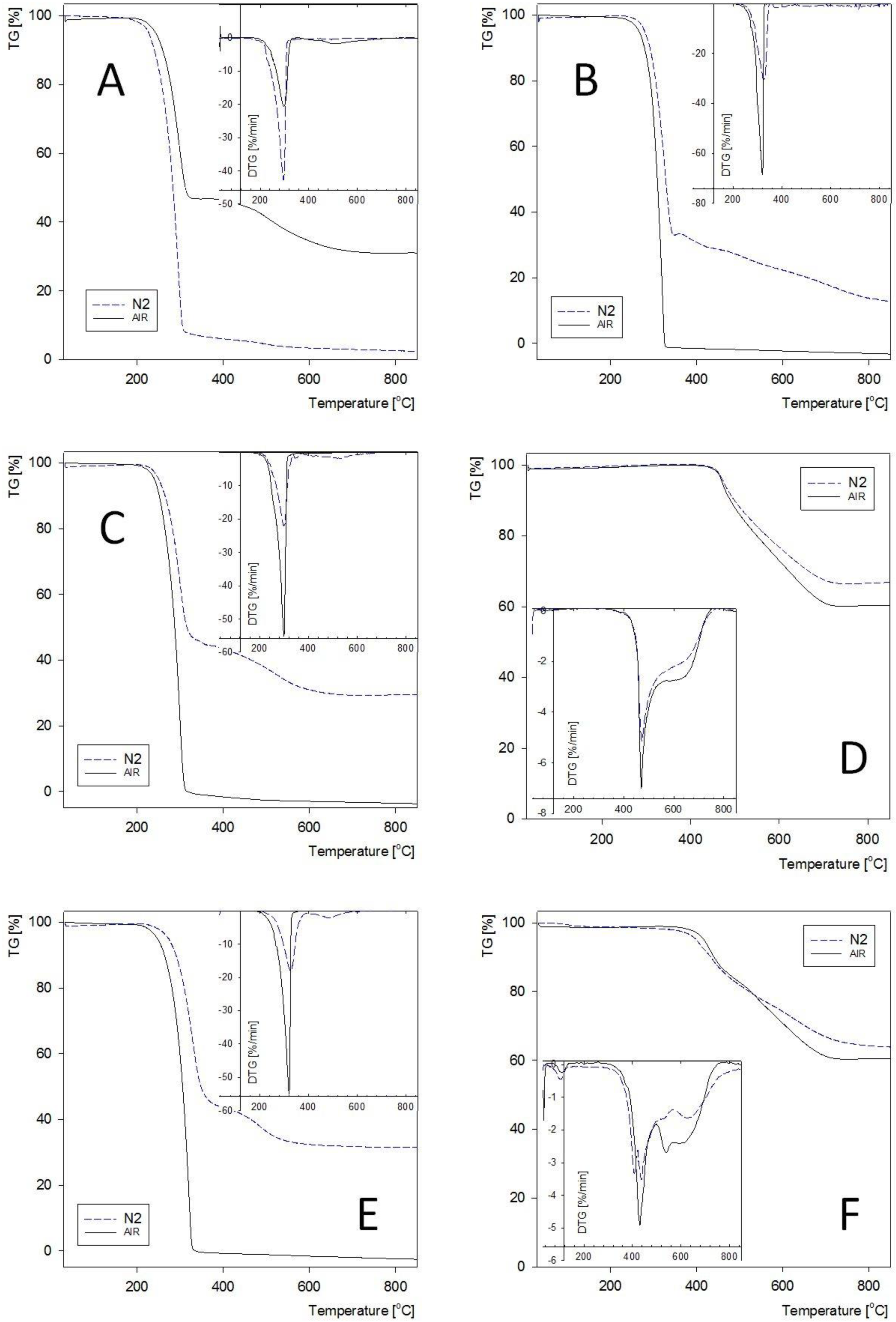
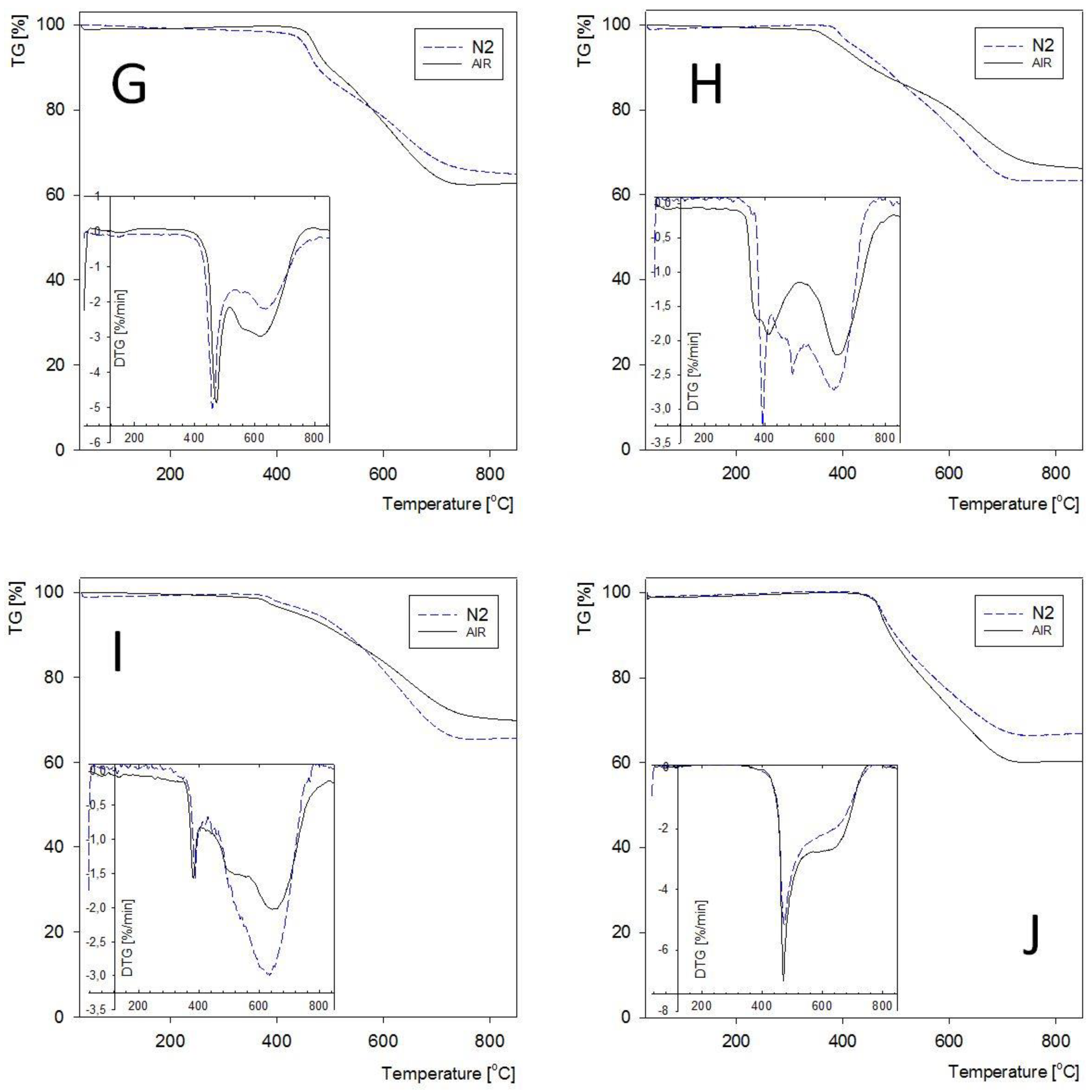
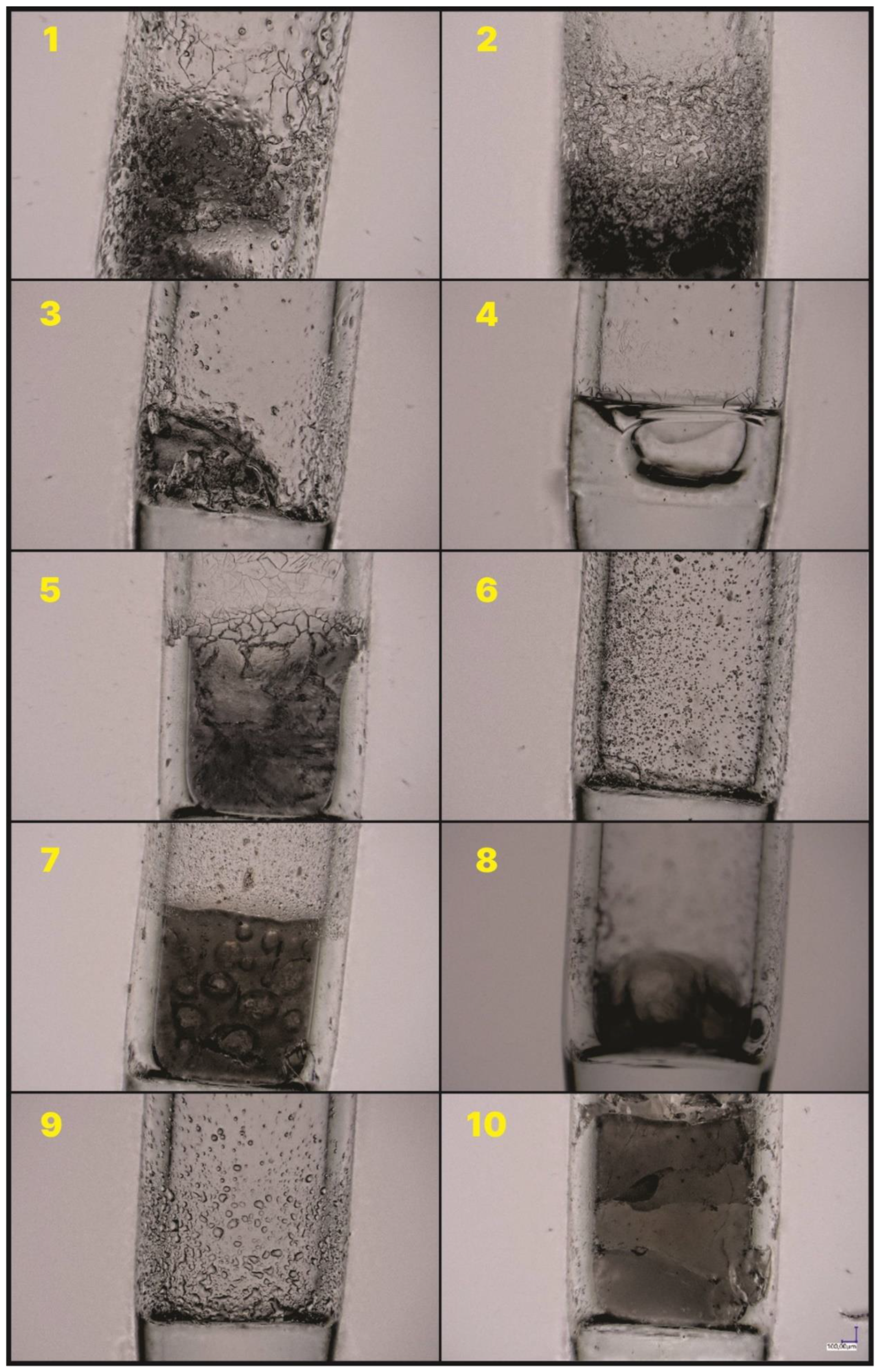
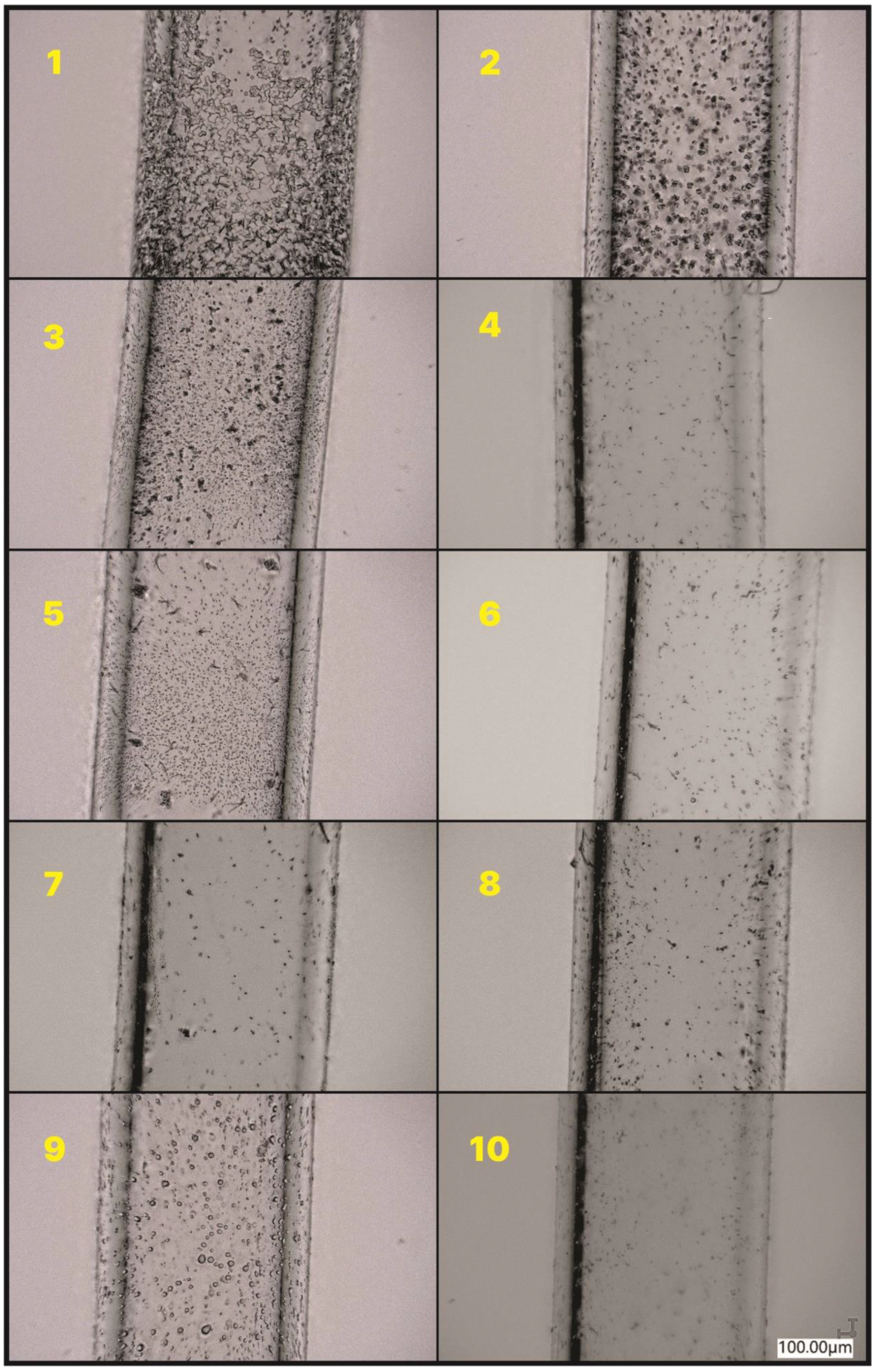
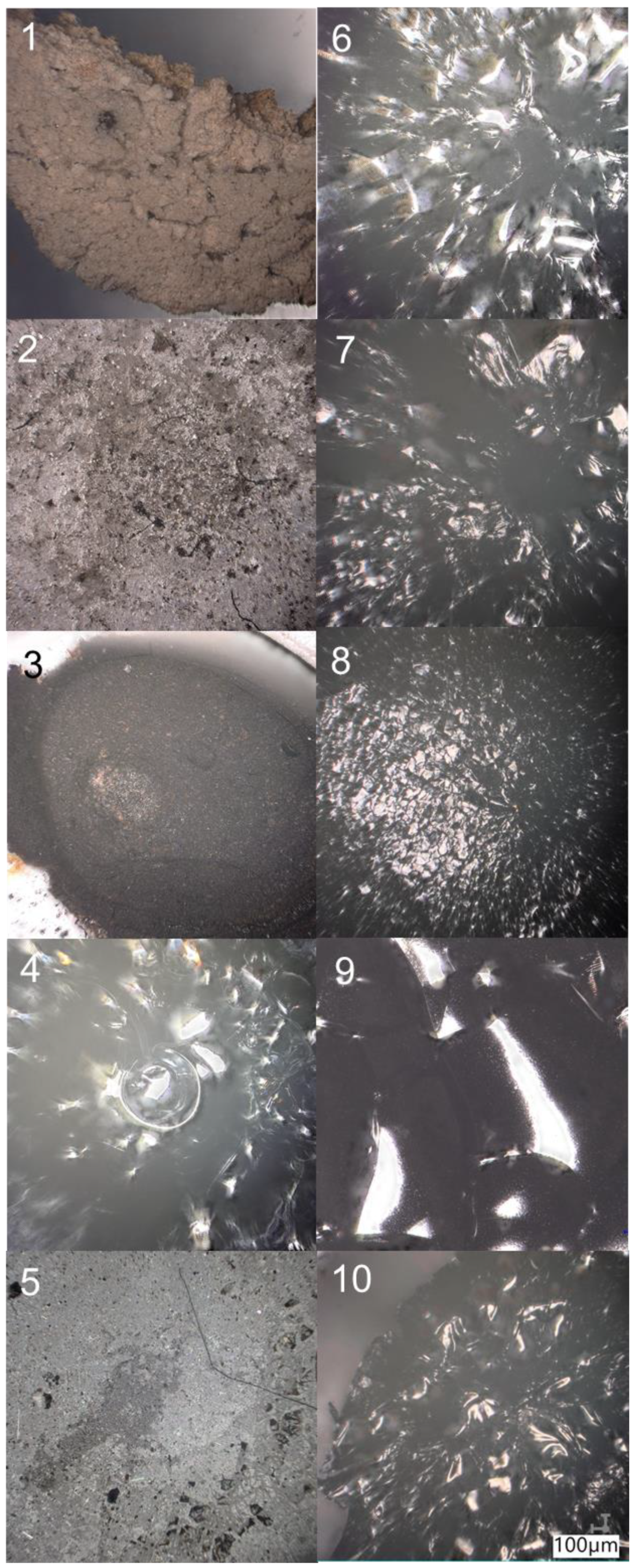
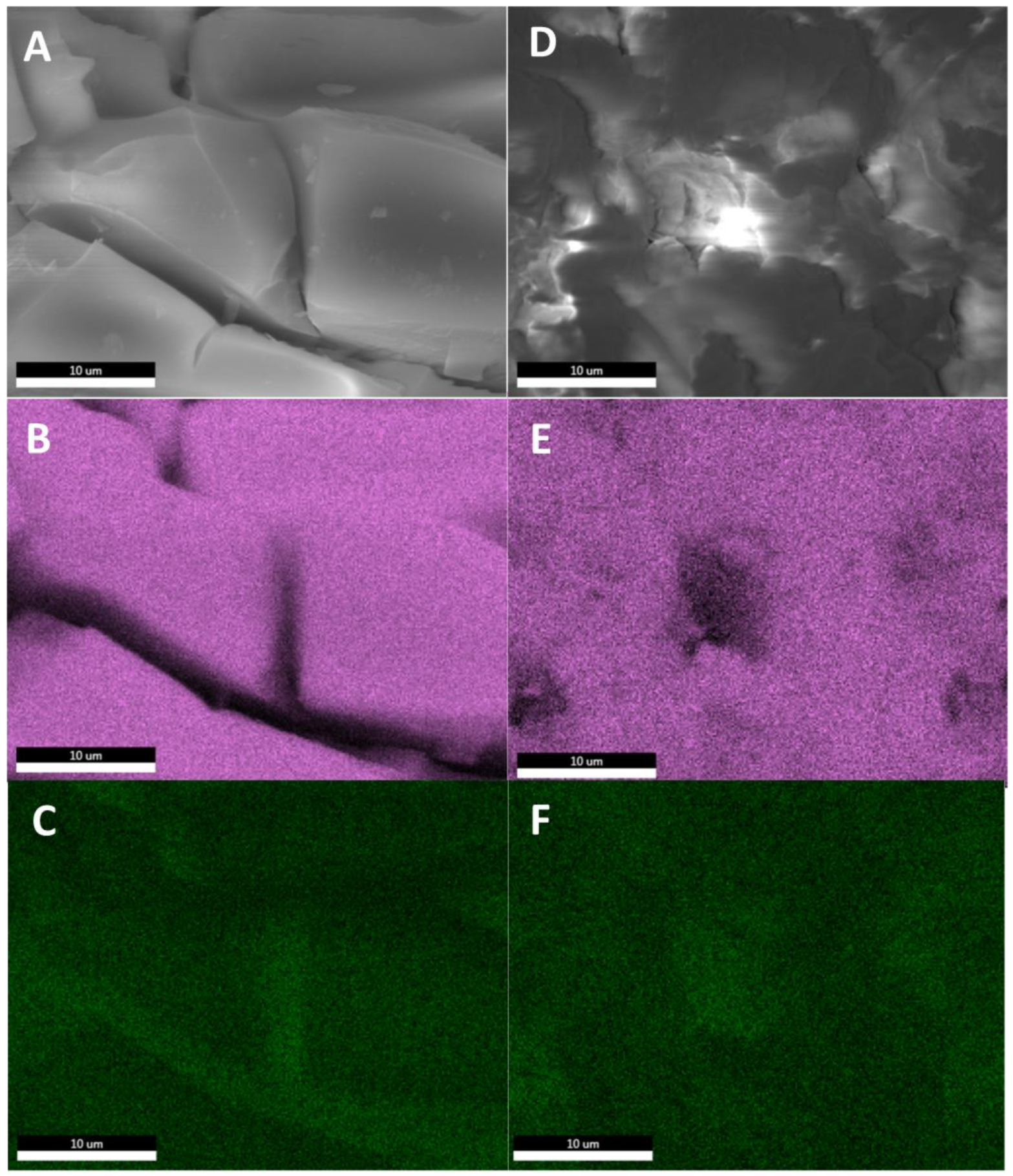

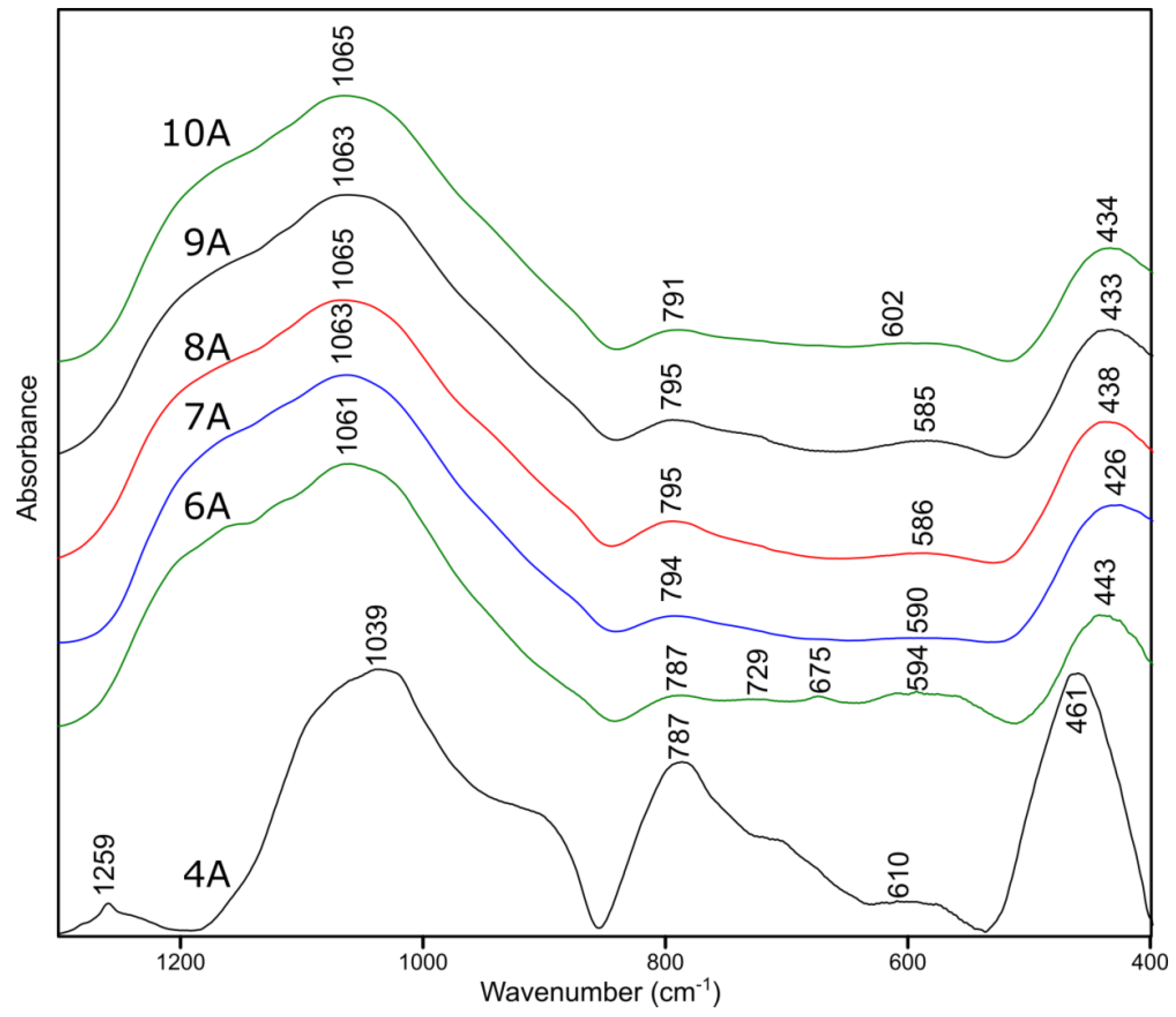

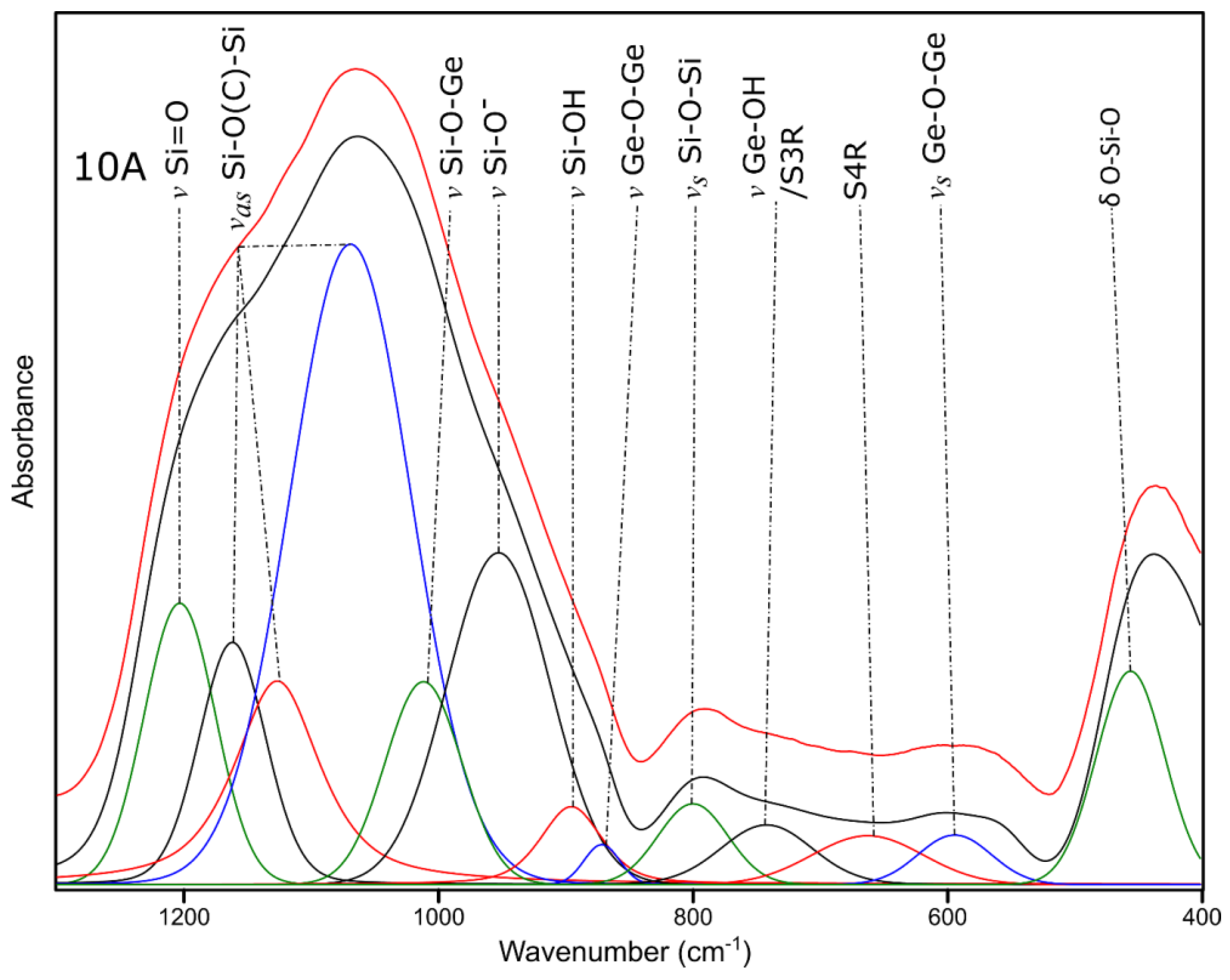
| iBu7Si7O8Ge–R | Ph7Si7O8Ge–R | ||
|---|---|---|---|
| No. | R | No. | R |
| 1 |  | 6 |  |
| 2 |  | 7 |  |
| 3 | 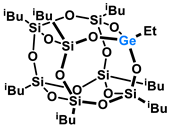 | 8 |  |
| 4 | 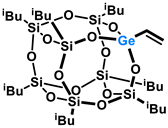 | 9 | 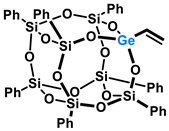 |
| 5 | 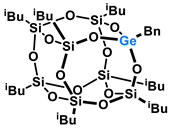 | 10 |  |
| Air | Nitrogen | ||||||||||||
|---|---|---|---|---|---|---|---|---|---|---|---|---|---|
| Ge POSS | M | mC [%] | mA [%] | mB [%] | pD [%] | pTG [%] | P5 [%] | P98 [%] | DTGmax [°C] | pTG [%] | P5 [%] | P98 [%] | DTGmax [°C] |
| 1 | 876 | 53.5 | 38.79 | 1.72 | 59.9% | 46.7 | 246 | 751 | 297 | 2.6 | 229 | 752 | 304 |
| 2 | 938 | 50.0 | 36.23 | 8.22 | 55.9% | 47.3 | 278 | 756 | 320 | 0 | 267 | 329 | 320 |
| 3 | 890 | 52.7 | 38.18 | 3.26 | 58.9% | 44.5 | 252 | 696 | 300 | 0 | 242 | 314 | 300 |
| 4 | 888 | 52.8 | 38.27 | 3.05 | 59.1% | 56.24 | 303 | 660 | N.a. | 13.5 | 238 | 770 | Na. |
| 5 | 952 | 49.3 | 35.69 | 9.57 | 55.1% | 31.5 | 276 | 680 | 329 | 0 | 250 | 336 | 321 |
| 6 | 1016 | 46.2 | 53.13 | 1.48 | 51.6% | 60.3 | 424 | 741 | 431 | 63.8 | 410 | >850 | 407/437 |
| 7 | 1078 | 43.5 | 50.07 | 7.15 | 48.7% | 58.8 | 472 | 755 | 467 | 52.6 | 460 | 719 | 466 |
| 8 | 1030 | 45.6 | 52.4 | 2.82 | 50.9% | 63.3 | 422 | 738 | 394/631 | 66.1 | 397 | 828 | 412/639 |
| 9 | 1028 | 45.6 | 52.5 | 2.63 | 51.0% | 65.4 | 459 | 773 | 378/634 | 69.9 | 467 | >850 | 382/646 |
| 10 | 1092 | 43.0 | 49.43 | 8.34 | 48.0% | 66.4 | 475 | 753 | 472 | 60.0 | 471 | 740 | 470 |
Publisher’s Note: MDPI stays neutral with regard to jurisdictional claims in published maps and institutional affiliations. |
© 2022 by the authors. Licensee MDPI, Basel, Switzerland. This article is an open access article distributed under the terms and conditions of the Creative Commons Attribution (CC BY) license (https://creativecommons.org/licenses/by/4.0/).
Share and Cite
Skoczeń, A.; Frąckowiak, D.; Przekop, R.E.; Frydrych, M.; Kasperkowiak, M.; Jeleń, P.; Sitarz, M.; Marciniec, B. New Ceramics Precursors Containing Si and Ge Atoms—Cubic Germasilsesquioxanes—Synthesis, Thermal Decomposition and Spectroscopic Analysis. Molecules 2022, 27, 1441. https://doi.org/10.3390/molecules27041441
Skoczeń A, Frąckowiak D, Przekop RE, Frydrych M, Kasperkowiak M, Jeleń P, Sitarz M, Marciniec B. New Ceramics Precursors Containing Si and Ge Atoms—Cubic Germasilsesquioxanes—Synthesis, Thermal Decomposition and Spectroscopic Analysis. Molecules. 2022; 27(4):1441. https://doi.org/10.3390/molecules27041441
Chicago/Turabian StyleSkoczeń, Aleksandra, Dawid Frąckowiak, Robert E. Przekop, Miłosz Frydrych, Małgorzata Kasperkowiak, Piotr Jeleń, Maciej Sitarz, and Bogdan Marciniec. 2022. "New Ceramics Precursors Containing Si and Ge Atoms—Cubic Germasilsesquioxanes—Synthesis, Thermal Decomposition and Spectroscopic Analysis" Molecules 27, no. 4: 1441. https://doi.org/10.3390/molecules27041441
APA StyleSkoczeń, A., Frąckowiak, D., Przekop, R. E., Frydrych, M., Kasperkowiak, M., Jeleń, P., Sitarz, M., & Marciniec, B. (2022). New Ceramics Precursors Containing Si and Ge Atoms—Cubic Germasilsesquioxanes—Synthesis, Thermal Decomposition and Spectroscopic Analysis. Molecules, 27(4), 1441. https://doi.org/10.3390/molecules27041441









